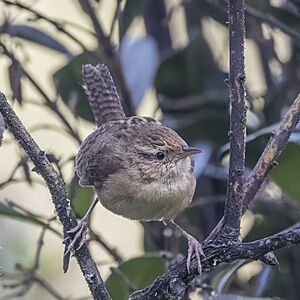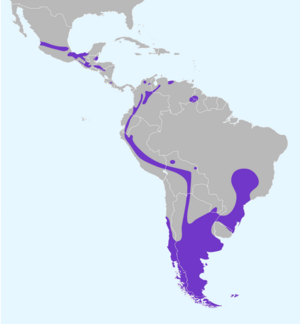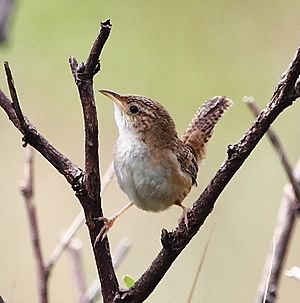Grass wren facts for kids
Quick facts for kids Grass wren |
|
|---|---|
 |
|
| C. p. aequatorialis, Colombia | |
| Conservation status | |
| Scientific classification | |
 |
The grass wren (Cistothorus platensis) is a small species of passerine bird, which means it's a type of perching bird. It belongs to the Troglodytidae family, also known as the wrens. You can find this bird in many parts of central and southern America.
Contents
About the Grass Wren's Name and Family
The grass wren was first described in 1790 by an English bird expert named John Latham. He gave it the scientific name Sylvia platensis. Later, in 1850, a German ornithologist named Jean Cabanis placed it in its current genus called Cistothorus.
For a long time, the grass wren and the sedge wren were thought to be the same species. But thanks to new studies using molecular phylogenetic methods (which look at DNA), scientists realized they were actually different species. Major bird organizations like the International Ornithological Committee (IOC) and the American Ornithological Society (AOS) now agree that they are separate. There are currently 17 different types, or subspecies, of the grass wren recognized by scientists.
What Does the Grass Wren Look Like?
The grass wren is a small bird, about 10 to 10.5 centimeters (4 to 4.1 inches) long. Its upper body is a buffy brown color with black and buffy white stripes on its back. Its wings and tail have dark bands. The underside of its body is mostly buffy, which is a pale yellowish-brown color.
Where Do Grass Wrens Live?
You can find the grass wren in many places, though not always continuously. They live from central Mexico, south through countries like Belize, Guatemala, Honduras, Nicaragua, and Costa Rica. In South America, they are found in almost every country except French Guiana and Suriname. They also live on the Falkland Islands.
Grass wrens like to live in specific kinds of places. In Colombia and Ecuador, they prefer moist, grassy areas and places with sedges (grass-like plants). They can also be found in clearings, farm areas, and valleys between mountains. In Brazil, they live in areas called cerrado (a type of savanna), grasslands, and marshes.
Grass Wren Behavior
Non-breeding Nests
Male grass wrens are known for building special nests even when they are not ready to have chicks. They build two types: simple platforms and "dummy nests." Platforms are just small piles of grass hidden in plants. Dummy nests look like real dome-shaped nests, but they are empty.
Scientists aren't completely sure why they build these extra nests. One idea is that the males might be trying to impress females to get them to choose them as a mate. They might also be trying to encourage females to start laying eggs earlier than they might otherwise.
Grass Wren Sounds
The grass wren has a unique song. It's described as a series of short, high-pitched notes. These can sound like high rattles, sharp trills, or even like a sparrow's "tr-tr-tr-tr." They also make a nasal "zèzèzèzè" sound. You can often hear their songs in the grassy areas where they live.
Grass Wren Status
The IUCN (International Union for Conservation of Nature) keeps track of how many animals are left in the wild. They have assessed the grass wren as a species of "Least Concern." This means that there are still many grass wrens in the world, and they are not currently at high risk of disappearing.



